Add One of These 21 Pretty Flowers That Look Like Roses to Your Garden
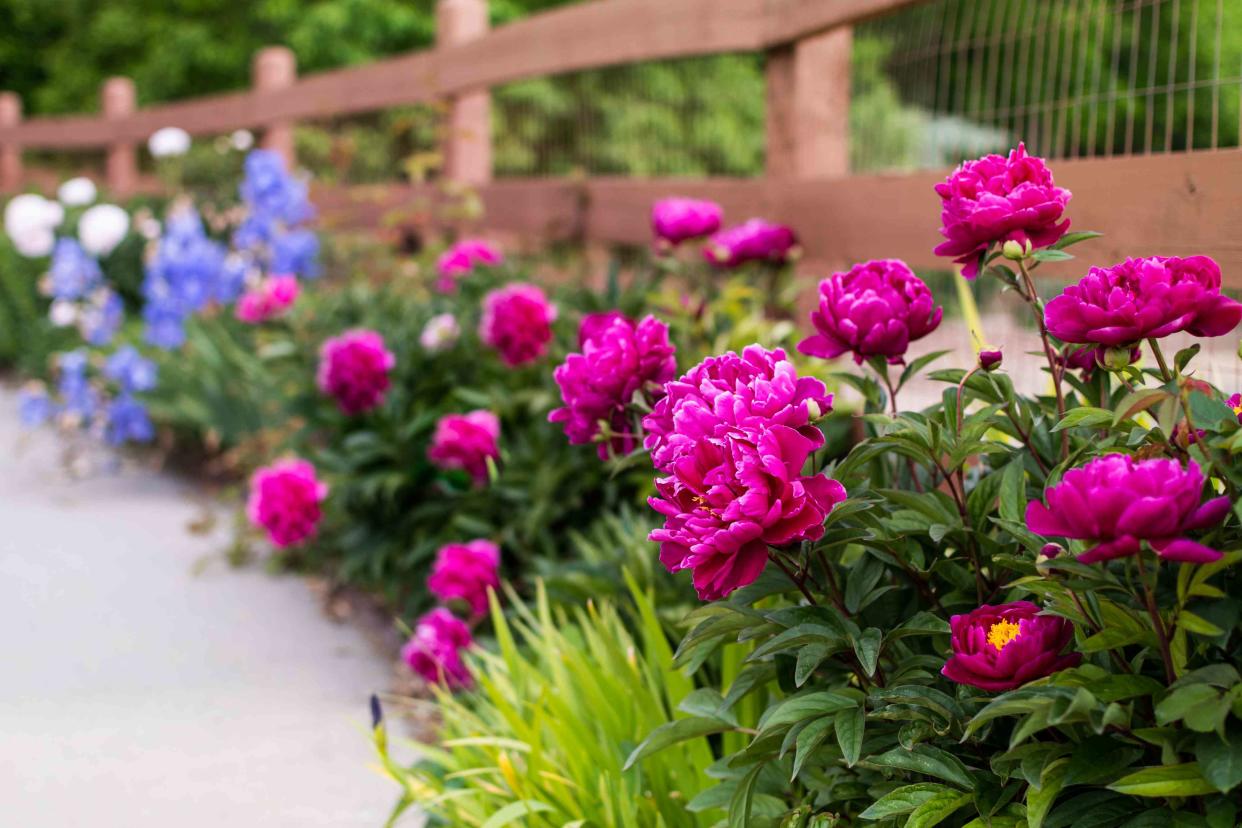
The Spruce / Meg MacDonald
Fact checked by Haley Mades
Flowers that look like roses bring beauty and visual interest to your garden but offer advantages, like broader care requirements, fewer or no thorns, and a cheaper price tag at the nursery.
Whether you’re looking for a fragrant flower that appeals to the senses like a rose or a prolific bloomer for your cut flower garden, here are 21 plants and shrubs that produce flowers that look like roses.
Ranunculus (Ranunculus spp.)
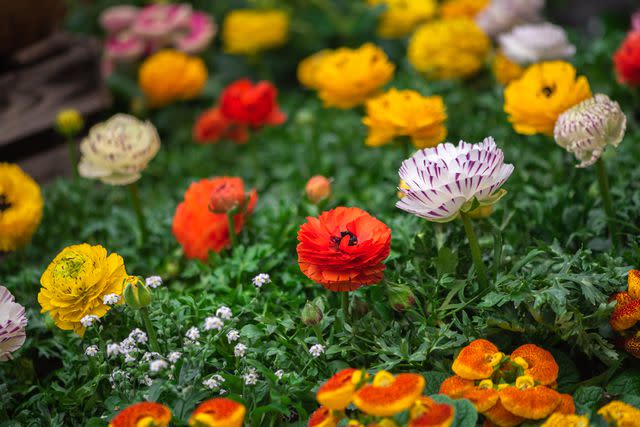
The Spruce / Evgeniya Vlasova
Ranunculus blooms resemble roses, especially if you choose a double-bloom variety that displays many layers of thin petals in shades like pink, orange, red, and white. In particular, the vibrant red hue of 'Tango' ranunculus is a striking alternative to a bouquet of red roses.
A popular choice for cut flower gardens, ranunculus begins blooming in the spring along with tulips and daffodils, so expect an earlier flush of blooms than what you will see for most rose bushes.
USDA Hardiness Zones: 8-10
Flower Color Varieties: Yellow, pink, orange, red, white, purple
Light: Full sun
Soil Needs: Loamy, well-drained; neutral pH
Mature Size: 2 in. to 2 ft. tall
Deer Resistant: Yes
Peonies (Paeonia officinalis)
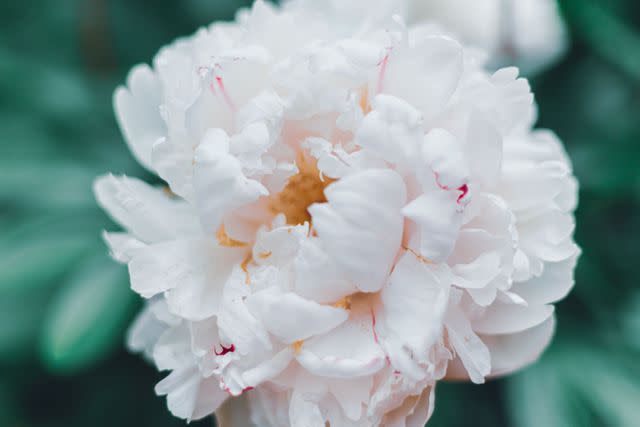
The Spruce / Autumn Wood
Peonies are one of the most popular and fragrant flowers that look like roses. There are 33 species within the Paeonia genus but the showier varieties, like Paeonia lactiflora 'Pink Hawaiian Coral' have delicate ruffled petals and oversized bloom that makes a statement in a vase or bouquet.
You’ll find peonies in a range of colors, but soft hues like pink, white, and coral are some of the most popular options for rose look-alikes.
USDA Hardiness Zones: 3-8
Flower Color Varieties: White, pink, rose, red, deep purple, and coral
Light: Full sun
Soil Needs: Well-drained; neutral pH
Mature Size: 3 ft. tall, 3-4 ft. wide
Deer Resistant: Yes
Carnations (Dianthus caryophyllus)
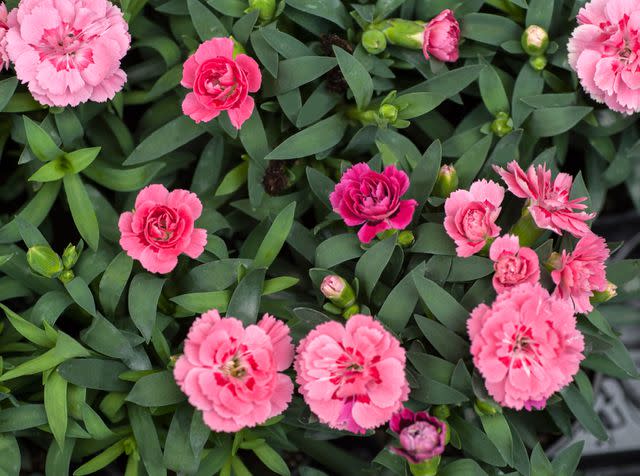
The Spruce / Evgeniya Vlasova
Carnations exhibit long-lasting vibrancy once cut, making them an ideal choice for flower bouquets and arrangements.
The small, round blooms have layers of ruffled petals and are sometimes mistaken for roses, although the flower’s slightly spicy scent is a distinct contrast from the sweet fragrance of a rose.
USDA Hardiness Zones: 6-9
Flower Color Varieties: White, pink, red
Light: Full, partial sun
Soil Needs: Well-drained; alkaline pH
Mature Size: 6-24 in. tall, 10-14 in. wide
Deer Resistant: Yes
Double tulips (Tulipa x)
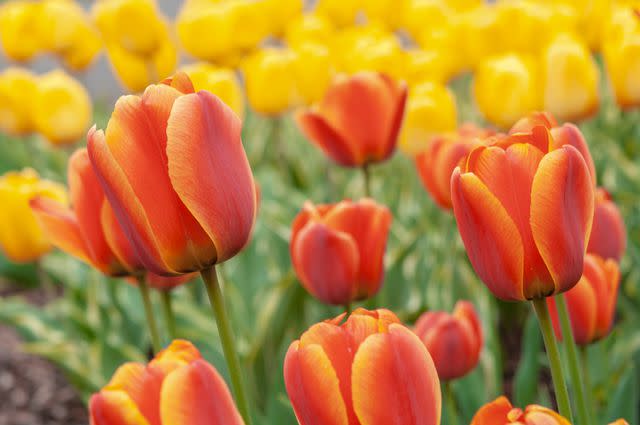
The Spruce / Evgeniya Vlasova
While the standard tulip variety is unlikely to be mistaken for a rose, double tulip hybrids have a fuller, round appearance. You’ll see double tulips in colors like red, white, purple, pink, orange, yellow, along with bicolor varieties.
Like conventional tulips, double tulips are spring bloomers so you might plant these flowers that look like roses for an early display of showy, attractive flowers—minus the thorns!
USDA Hardiness Zones: 3-8
Flower Color Varieties: Red, white, purple, pink, orange, yellow, and bicolors
Light: Full sun
Soil Needs: Rich, well-drained; acidic, neutral pH
Mature Size: 9–24 in. tall, 6–9 in. wide
Deer Resistant: No
Gardenias (Gardenia jasminoides)
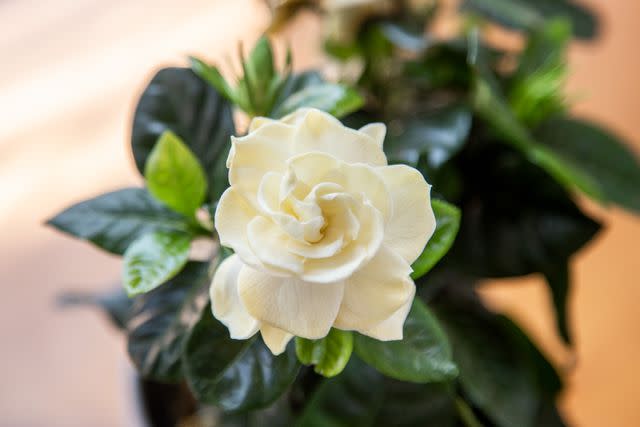
The Spruce / Krystal Slagle
With fragrant and attractive white flowers, it’s not hard to understand the appeal of this tropical, evergreen shrub. Gardenia flowers look like roses with petals that spiral towards the center of the bloom.
The shrub is notoriously high-maintenance, which is another trait it shares with many varieties of roses.
USDA Hardiness Zones: 7-11
Flower Color Varieties: White
Light: Partial sun
Soil Needs: Well-drained; acidic pH
Mature Size: 5-6 ft. tall, 5-6 ft. wide
Deer Resistant: Yes
Camellia (Camellia spp.)
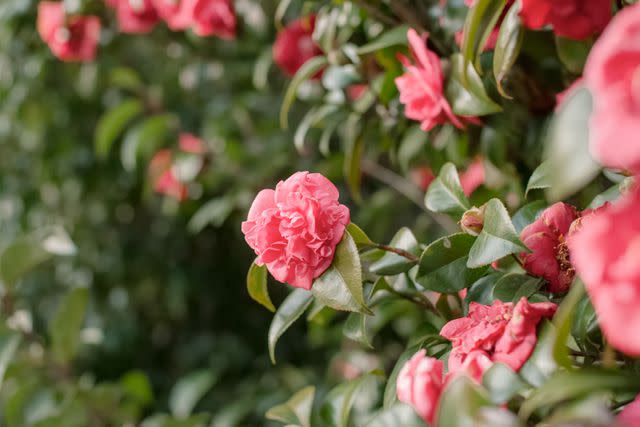
The Spruce / Kara Riley
Camellia flowers are often compared to roses because they have lush petaled blooms. Flower colors include pink, red, and white but yellow and lavender varieties are possible too.
Camellia is also often compared to another rose look-alike, the peony, but it grows in warmer weather climates and most species have little to no fragrance.
USDA Hardiness Zones: 7-9
Flower Color Varieties: White, pink, red, yellow, or lavender
Light: Partial sun
Soil Needs: Rich, moist but well-drained; acidic pH
Mature Size: 2–12 ft. tall, 2–10 ft. wide (depends on variety)
Deer Resistant: Sometimes
Lisianthus (Eustoma grandflorum)
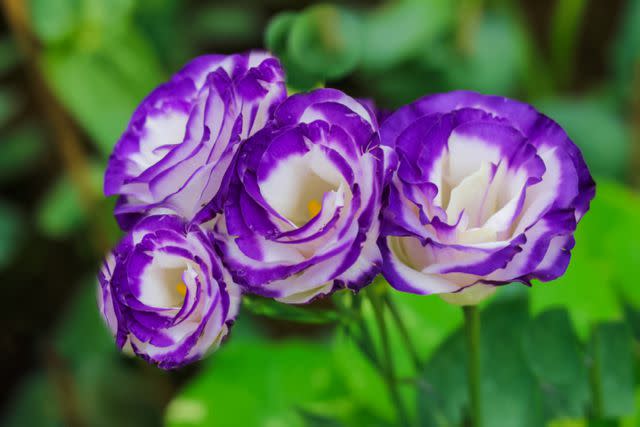
The Spruce / K. Dave
With the ability to stay perky for up to two weeks, lisianthus is an impressively long-lasting cut flower. The large flowers have petals that gently flare outward, giving the bloom a bell-like shape that resembles a rose.
Pink and white lisianthus varieties make a good stand-in for roses while the purple variety stands out as unique when compared to the typical selection of rose colors.
USDA Hardiness Zones: 8-10
Flower Color Varieties: Purple, pink, white
Light: Full sun
Soil Needs: Moist, well-drained; neutral pH
Mature Size: 1–3 ft. tall, 6–12 in. wide
Deer Resistant: Yes
Dahlia (Dahlia spp.)
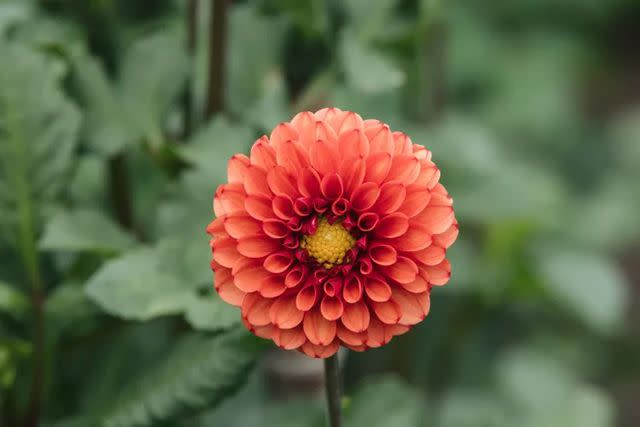
The Spruce / LetÃcia Almeida
Dahlias have varying types of blooms—some are tightly rolled and pointy while others are flat with far fewer petals.
Dinner plate dahlias, in particular, are most likely to draw a comparison to a rose because of their showy blooms, which measure 8-inches or more in size.
USDA Hardiness Zones: 7-10
Flower Color Varieties: Red, Pink, Orange, Yellow, Purple, White
Light: Full sun
Soil Needs: Loamy, well-drained; neutral, acidic pH
Mature Size: 1-6 ft. tall, 1-3 ft. wide
Deer Resistant: Sometimes
Begonia
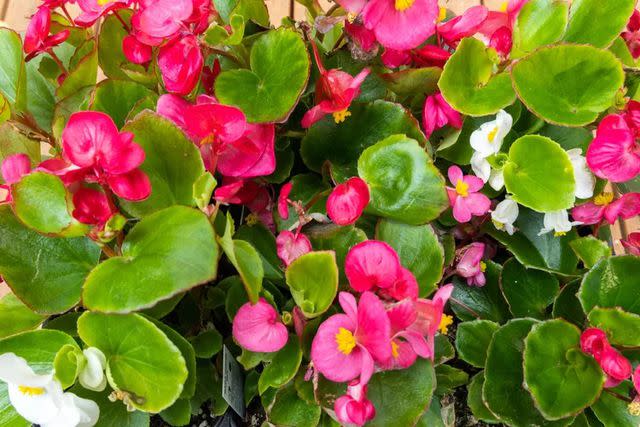
The Spruce / Jayme Burrows
A low-maintenance garden favorite, some begonia varieties have flowers that look like roses. This is especially true of hybrid tuberous begonias, which have thin, slightly ruffled petals and come in shades like red, yellow, orange, pink, and white. Though they are perennials, they’re most often grown as annuals.
USDA Hardiness Zones: 10-11
Flower Color Varieties: Pink, red, white, yellow, orange
Light: Partial sun to shade
Soil Needs: Moist, rich; acidic pH
Mature Size: Varies, 6-18 inches
Deer Resistant: Sometimes
Anemone (Anemone spp.)
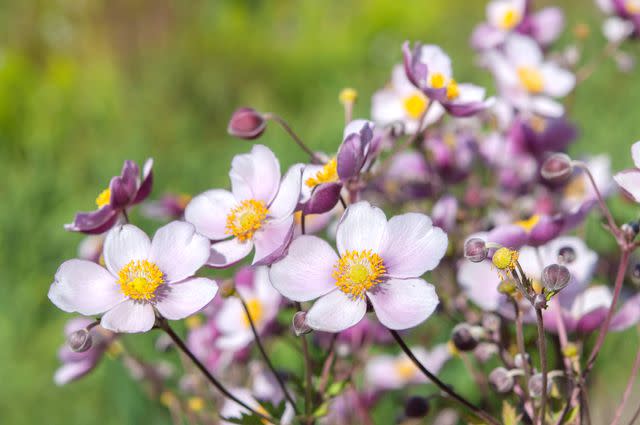
The Spruce / Evgeniya Vlasova
Anemones are a genus of flowers best known for their broad, flat petals that often circle a dark, contrasting center. Double anemones are the most similar to roses, with a fuller appearance that mimics the more ornate petal arrangement of roses.
The 'Queen Charlotte' hybrid is one example of this type of anemone—it has a double row of soft pinkish-white petals that resemble some floribunda roses.
USDA Hardiness Zones: 4-9
Flower Color Varieties: Red, orange, yellow-green, blue, purple, red-purple, white, ivory, pink
Light: Full to partial sun
Soil Needs: Rich, moist; acidic, neutral pH
Mature Size: 6 in.-4 ft. tall, 2-3 ft. wide
Deer Resistant: Yes
Cotton rose (Hibiscus mutabilis)
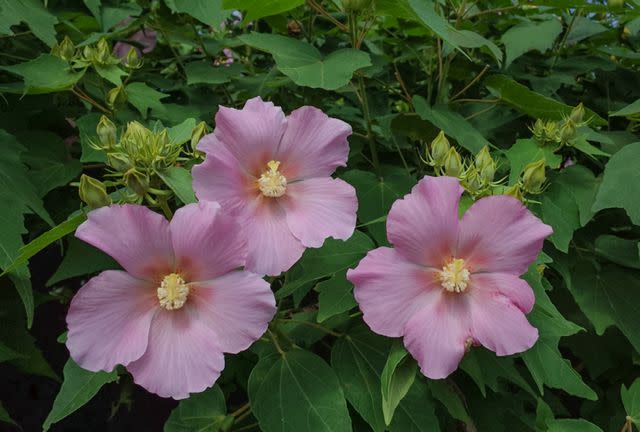
The Spruce / K. Dave
A hibiscus plant may not seem like an obvious substitute for a rose bush but especially in tropical climates, the cotton rose may be the most similar option. This type of hibiscus shrub produces flowers with five large petals that transition from white to pink to red over the span of several days.
While the petal structure is simpler than most rose varieties, the delicate beautiful flowers have earned this plant the common name of ‘cotton rose’ and it’s a worthwhile option to consider if you’re seeking a heat-tolerant rose alternative.
USDA Hardiness Zones: 7-9
Flower Color Varieties: White, pink, red
Light: Full, partial sun
Soil Needs: Loamy, well-drained; neutral, alkaline pH
Mature Size: 6–15 ft. tall, 6–10 ft. wide
Deer Resistant: Yes
Moss rose (Portulaca grandiflora)
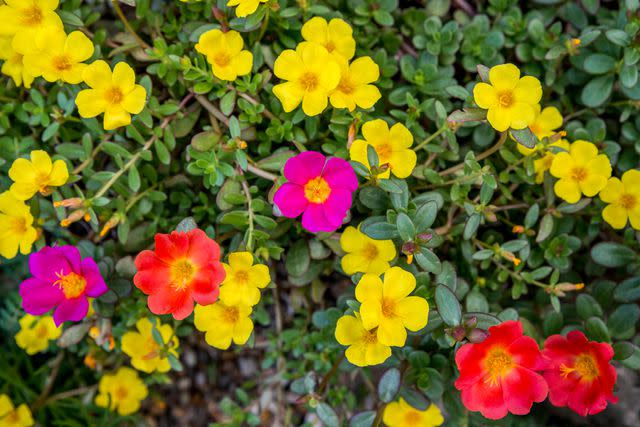
The Spruce / Adrienne Legault
The moss rose is not actually a rose; it’s an annual succulent that is part of the Portulacaceae family. As a succulent, it offers the advantage of being much more drought- and heat-tolerant than many species of roses.
There are varieties with single, semi-double, and double blooms to pick from. Regardless of which one you choose, the flowers have a unique habit of opening during the day and closing at night.
USDA Hardiness Zones: 2-11
Flower Color Varieties: White, orange, yellow, red, pink
Light: Full sun
Soil Needs: Sandy, well-drained; neutral, acidic pH
Mature Size: 3–8 in. tall, 6–12 in. wide
Deer Resistant: Yes
Daffodil (Narcissus spp.)
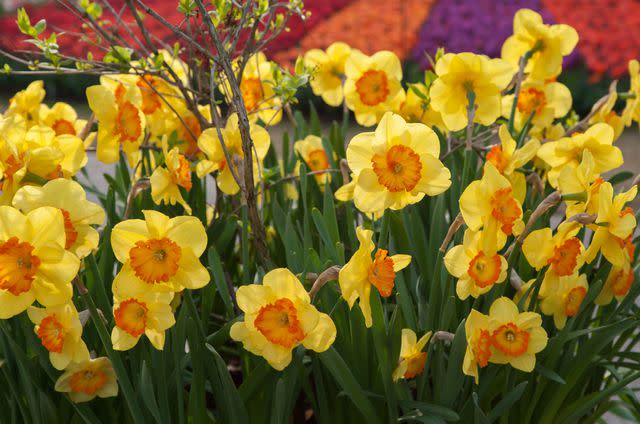
The Spruce / Evgeniya Vlasova
Daffodils may not immediately come to mind as a flower that looks like a rose, but there are dozens of Narcissus species with varying features.
Daffodils are classified into different groups and division 4 includes double-petaled daffodils that do bear a resemblance to roses. The 'Sir Winston Churchill' variety is one example; it has a double row of white frilly petals surrounding a yellow center.
USDA Hardiness Zones: 4-8
Flower Color Varieties: Yellow, white, orange, pink
Light: Full, partial sun
Soil Needs: Rich, moist but well-drained; neutral, acidic pH
Mature Size: 6–30 in. tall, 6–12 in. wide
Deer Resistant: Yes
Flowering quince (Chaenomeles speciosa)
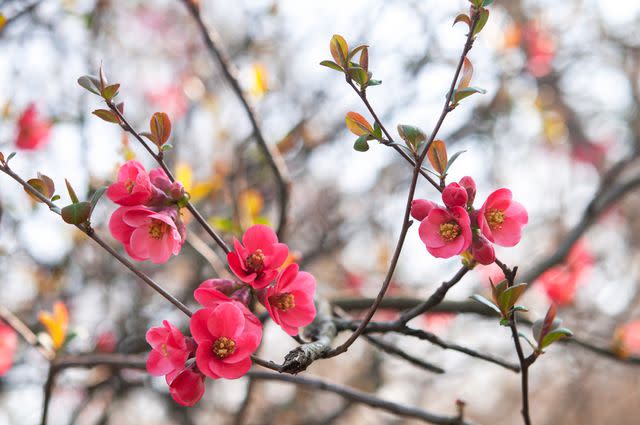
The Spruce / Evgeniya Vlasova
Just like roses, flowering quince belongs to the Rosacea family. Although closely related, this ornamental shrub isn’t a rose. Before foliage appears, the shrub produces delicate blossoms along its woody stems for a springtime show of color.
The ‘Cameo’ cultivar especially bears a rose-like resemblance with its showy apricot-colored double blossoms. It makes for a good border hedge but beware of its thorns.
USDA Hardiness Zones: 5-9
Flower Color Varieties: White, orange, red, pink
Light: Full sun
Soil Needs: Moist, well-drained; acidic, neutral pH
Mature Size: 3-10 ft. tall, 3-10 ft. wide
Deer Resistant: Yes
Oriental poppy (Papaver orientale)
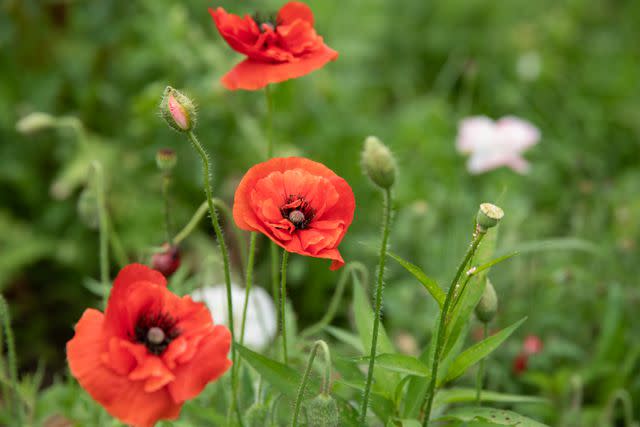
The Spruce / Leticia Almeida
The Oriental poppy has unique characteristics that make it stand out but the showy petals and vibrant hues cause it to resemble some varieties of rose. That’s especially true of semi-double or double bloom varieties, like Papaver orientale 'Fireball’.
USDA Hardiness Zones: 3-7
Flower Color Varieties: Orange, red, pink, purple, white
Light: Full sun
Soil Needs: Well-drained; neutral pH
Mature Size: 3 ft. tall, 3-4 ft. wide
Deer Resistant: Yes
Double impatiens
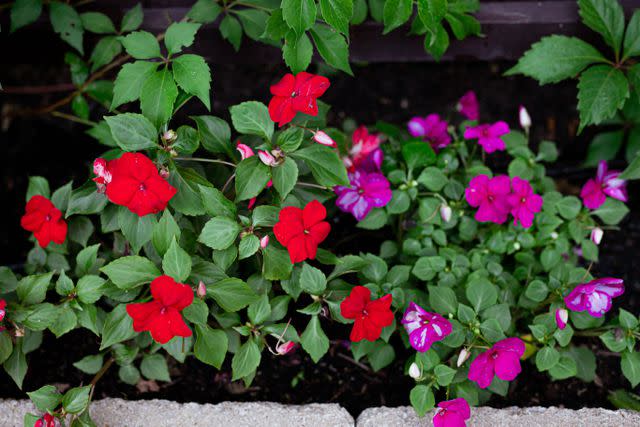
The Spruce / Autumn Wood
Shade-loving impatiens may not strike you as a rose lookalike, but double impatiens have more petals and a showier appearance that lands them on the list of flowers that look like roses.
They’re available in colorful shades like pink, purple, yellow, and orange. While roses typically require full sun, you can plant double impatiens in shady locations as long as the soil is well-drained.
USDA Hardiness Zones: 10-11
Flower Color Varieties: White, red, pink, orange, purple, yellow
Light: Partial to full shade
Soil Needs: Well-drained; acidic pH
Mature Size: 6–36 in. tall; 1–3 ft. wide
Deer Resistant: No
Japanese rose (Kerria japonica)
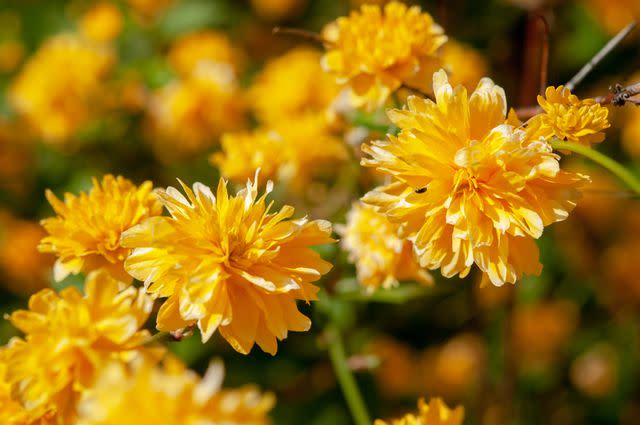
The Spruce / Evgeniya Vlasova
The Japanese rose belongs to the Rosaceae family but is not in the same genus as the common rose. Its claim to fame is that it’s a vigorous bloomer in shady conditions—which can’t be said for sun-loving roses.
During the spring, the flowering bush produces yellow flowers with five petals but the foliage provides visual interest during the entire growing season.
USDA Hardiness Zones: 4-9
Flower Color Varieties: Yellow
Light: Partial to full shade
Soil Needs: Moist but well-drained, loamy; acidic, neutral, alkaline pH
Mature Size: 5–10 ft. tall, 6–10 ft. wide
Deer Resistant: Yes
Million bells (calibrachoa)
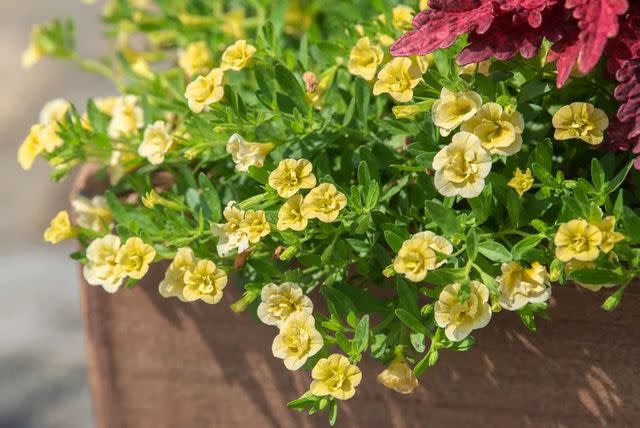
The Spruce / Evgeniya Vlasova
Million bells produce petite, 1-inch blooms that look like roses because of their double petal arrangement. The plant has a trailing growth habit that makes it especially well-suited to container gardens and it grows well in full sun to partial shade.
The flowers come in a wide range of shades, including eye-catching hues like coral, lavender, and burgundy.
USDA Hardiness Zones: 7-11
Flower Color Varieties: Coral, yellow, orange, red, pink, blue, purple, burgundy, lavender, cream
Light: Full sun to part shade
Soil Needs: Moist, rich, well-drained; acidic pH
Mature Size: 6–12 in. tall, 12–24 in. wide
Deer Resistant: No
Rhododendron (Rhododendron spp.)
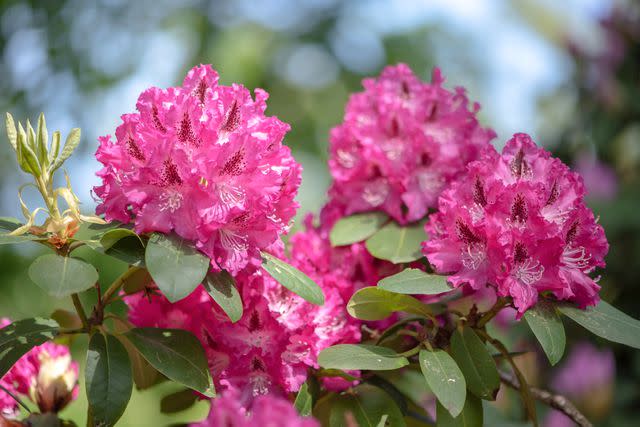
The Spruce / Evgeniya Vlasova
Rhododendron bushes are prized for their prolific blooming activity, and that’s why they’re often considered a worthwhile alternative to a rose bush.
The flowers don’t match up to a rose perfectly, but the clusters of blooms (often seen in pink, red, white, and other colors) offer a long-lasting display of color from spring through late summer.
There are more than 1,000 species within the Rhodendron genus but fans of roses might especially be drawn to the Catawba rhododendron, which has abundant clusters of beautiful pink flowers during the growing season.
USDA Hardiness Zones: 4-8
Flower Color Varieties: Red, pink, orange, yellow, purple, white
Light: Partial sun
Soil Needs: Moist, well-drained; acidic pH
Mature Size: 2-20 ft. tall, 3-15 ft. wide
Deer Resistant: No
Gloxinia (Sinningia)
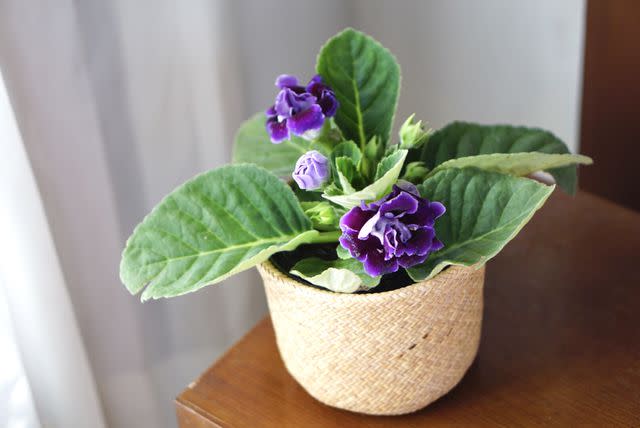
The Spruce / Gyscha Rendy
Gloxinia can be grown outdoors or indoors but their compact size makes them a good choice as a flowering houseplant.
A hybrid of Sinningia speciosa, these plants come in a wide range of colors and double-bloom varieties bear an especially strong resemblance to roses, with bell-shaped flowers that feature layers of slightly ruffled petals.
USDA Hardiness Zones: 11-12
Flower Color Varieties: White, red, pink, lavender, purple, or blue
Light: Partial to full shade
Soil Needs: Well-drained; acidic pH
Mature Size: 6-10 inches tall and wide
Deer Resistant: Yes
Azalea (Rhododendron spp.)
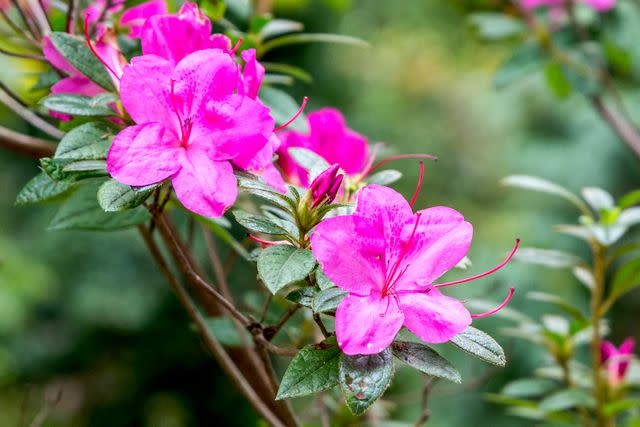
The Spruce / Adrienne Legault
Azaleas are part of the Rhododendron genus but exhibit differences in foliage and blooms compared to other rhododendron species. The azalea has smaller foliage and five stamens protruding from the center of each flower (rather than 10) and the bush matures to a smaller size than most rhododendrons.
There are many types of azaleas, but if you’re hoping for flowers that look like roses, top options include the Stewartstonian azalea with its bright red blossoms or the Bloom-a-Thon azalea, which produces double flowers in colors that include hot pink, red, or white.
USDA Hardiness Zones: 4-8
Flower Color Varieties: White, pink, purple, red, orange, yellow
Light: Full, partial sun
Soil Needs: Well-drained; acidic pH
Mature Size: 3–20 ft. tall, 3–20 ft wide
Deer Resistant: No
22 Unique Flowers to Grow in Your Garden
Read the original article on The Spruce.

